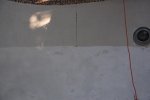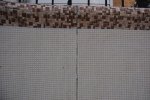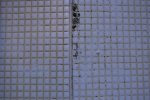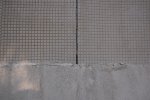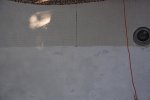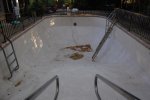We bought a house in November which has a 50 year-old pool in the back. (16 x 32 x 8 feet deep -- deep end). After working my rear end off every day through the winter and spring, we opened the pool and swam in it a couple times before it decided to spring a leak. It's a concrete pool with sidewalls covered with fiberglass "tile". (The actual walls may indeed also be gunite, and the fiberglass "tile" sheets might just be covering that. [?]) It is obvious that the joints between those panels have deteriorated. Strips of caulk could be seen "flapping" when the pool was full, and there is also obvious deterioration in the gunite where the floor meets the walls. The finish has become chalky and sandy, and there are pock marks in a few places.
Our pool guy wasn't able to find a specific leak. (It's not in the plumbing, we're pretty sure. No bubbles coming from the jet.) We had been refilling with a water hose, just so we could keep the pump working. But we decided to go ahead and drain it to make the repairs to those joints and the floor. (It did NOT stop leaking when the level got below the skimmer; it continued to leak.)
At this point, the pool is drained. I can see evidence of past repairs where the floor meets the walls, as well as the ones between the joints in the wall panels that I already mentioned. The pool guy suggests some patching before applying a new epoxy sealing coat. I am a DIY-er, so I would like to fix this myself -- or at least do as much of the work as I can. If I knew exactly what materials to use, I'm pretty sure I have the necessary skills. Also, the way I see it, NOW is the time to do anything else (fresh paint, etc.) while the pool is empty.
I suppose my first actual question is ... does my pool guy's suggestion sound like a reasonable solution? Are there any other considerations?
In case you haven't figured it out already, I have never owned a pool before.
Thank you,
Our pool guy wasn't able to find a specific leak. (It's not in the plumbing, we're pretty sure. No bubbles coming from the jet.) We had been refilling with a water hose, just so we could keep the pump working. But we decided to go ahead and drain it to make the repairs to those joints and the floor. (It did NOT stop leaking when the level got below the skimmer; it continued to leak.)
At this point, the pool is drained. I can see evidence of past repairs where the floor meets the walls, as well as the ones between the joints in the wall panels that I already mentioned. The pool guy suggests some patching before applying a new epoxy sealing coat. I am a DIY-er, so I would like to fix this myself -- or at least do as much of the work as I can. If I knew exactly what materials to use, I'm pretty sure I have the necessary skills. Also, the way I see it, NOW is the time to do anything else (fresh paint, etc.) while the pool is empty.
I suppose my first actual question is ... does my pool guy's suggestion sound like a reasonable solution? Are there any other considerations?
In case you haven't figured it out already, I have never owned a pool before.
Thank you,



